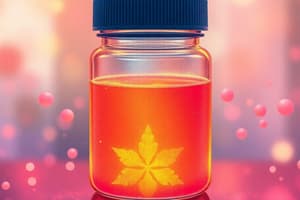Podcast
Questions and Answers
What is the main purpose of gel electrophoresis?
What is the main purpose of gel electrophoresis?
- To combine different components of a mixture based on their size and charge
- To gain knowledge of gene structure and expression
- To separate different components of a mixture based on their size and charge (correct)
- To analyze the biochemical techniques such as spectrophotometry and chromatography
Which molecules are typically separated using gel electrophoresis?
Which molecules are typically separated using gel electrophoresis?
- Malfunctions and abnormalities
- Strands of DNA, RNA, or different proteins (correct)
- Nucleic acids and spectrophotometry
- Carbohydrates and lipids
What properties are taken advantage of in gel electrophoresis experiments?
What properties are taken advantage of in gel electrophoresis experiments?
- Size, charge, and shape (correct)
- Temperature, pressure, and volume
- Color, texture, and weight
- Density, viscosity, and concentration
Which biochemical techniques are primarily developed to diagnose illnesses and abnormalities?
Which biochemical techniques are primarily developed to diagnose illnesses and abnormalities?
What is the purpose of applying an electric field across the gel in gel electrophoresis?
What is the purpose of applying an electric field across the gel in gel electrophoresis?
Which property determines the movement of molecules during gel electrophoresis?
Which property determines the movement of molecules during gel electrophoresis?
In SDS-PAGE, what does sodium dodecyl sulfate (SDS) do to the proteins?
In SDS-PAGE, what does sodium dodecyl sulfate (SDS) do to the proteins?
Why do smaller strings travel faster than longer strings in SDS-PAGE?
Why do smaller strings travel faster than longer strings in SDS-PAGE?
What is the main factor that determines the speed at which different strands of DNA and RNA move?
What is the main factor that determines the speed at which different strands of DNA and RNA move?
Why is protein separation more complicated than nucleic acid in types of SDS-PAGE?
Why is protein separation more complicated than nucleic acid in types of SDS-PAGE?
What effect does the presence of disulfide bonds have on the speed at which a protein travels in Reducing SDS-PAGE?
What effect does the presence of disulfide bonds have on the speed at which a protein travels in Reducing SDS-PAGE?
What is the main factor that determines how quickly different proteins move in SDS-PAGE?
What is the main factor that determines how quickly different proteins move in SDS-PAGE?
Why does the larger protein travel faster in nucleic acid separation despite being more negatively charged?
Why does the larger protein travel faster in nucleic acid separation despite being more negatively charged?
What does the addition of SDS to proteins achieve before running them on the gel in SDS-PAGE?
What does the addition of SDS to proteins achieve before running them on the gel in SDS-PAGE?
What is one reason for using SDS-PAGE to separate proteins just by their size?
What is one reason for using SDS-PAGE to separate proteins just by their size?
Gel electrophoresis separates different components of a mixture based on their size and charge, but not shape.
Gel electrophoresis separates different components of a mixture based on their size and charge, but not shape.
The main purpose of gel electrophoresis is to separate proteins based on their charge.
The main purpose of gel electrophoresis is to separate proteins based on their charge.
ELISA and PCR are primarily developed to diagnose illnesses and abnormalities.
ELISA and PCR are primarily developed to diagnose illnesses and abnormalities.
The presence of disulfide bonds has no effect on the speed at which a protein travels in Reducing SDS-PAGE.
The presence of disulfide bonds has no effect on the speed at which a protein travels in Reducing SDS-PAGE.
Chromatography is used to gain knowledge of biomolecules such as proteins, lipids, carbohydrates, and nucleic acids.
Chromatography is used to gain knowledge of biomolecules such as proteins, lipids, carbohydrates, and nucleic acids.
Spectrophotometry is mainly used to diagnose illnesses and malfunctions.
Spectrophotometry is mainly used to diagnose illnesses and malfunctions.
Proteins with a higher negative charge will always travel towards the positively charged anode more quickly in gel electrophoresis.
Proteins with a higher negative charge will always travel towards the positively charged anode more quickly in gel electrophoresis.
In gel electrophoresis, charge density is the only factor that determines the speed at which different proteins move.
In gel electrophoresis, charge density is the only factor that determines the speed at which different proteins move.
SDS-PAGE is primarily used to separate proteins based on their charge distribution and 3D shape.
SDS-PAGE is primarily used to separate proteins based on their charge distribution and 3D shape.
Gel electrophoresis can be used to separate molecules based solely on their aerodynamics.
Gel electrophoresis can be used to separate molecules based solely on their aerodynamics.
In reducing SDS-PAGE, the presence of disulfide bonds generally increases the speed at which a protein travels through the gel.
In reducing SDS-PAGE, the presence of disulfide bonds generally increases the speed at which a protein travels through the gel.
In SDS-PAGE, the addition of SDS causes proteins to maintain their natural 3D structure during the separation process.
In SDS-PAGE, the addition of SDS causes proteins to maintain their natural 3D structure during the separation process.
Gel electrophoresis is primarily used for diagnosing illnesses and abnormalities in biochemical techniques.
Gel electrophoresis is primarily used for diagnosing illnesses and abnormalities in biochemical techniques.
The primary purpose of gel electrophoresis is to separate molecules based solely on their size.
The primary purpose of gel electrophoresis is to separate molecules based solely on their size.
Nucleic acid separation is solely dependent on charge, not affected by factors such as size and shape.
Nucleic acid separation is solely dependent on charge, not affected by factors such as size and shape.
Proteins with fewer negative side chains will always travel faster in SDS-PAGE due to their smaller size.
Proteins with fewer negative side chains will always travel faster in SDS-PAGE due to their smaller size.
Flashcards are hidden until you start studying




